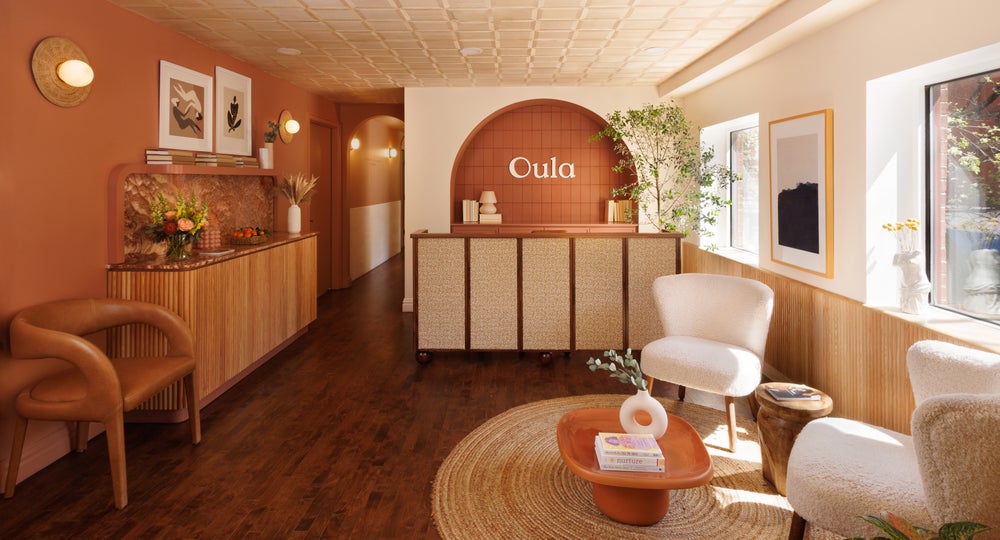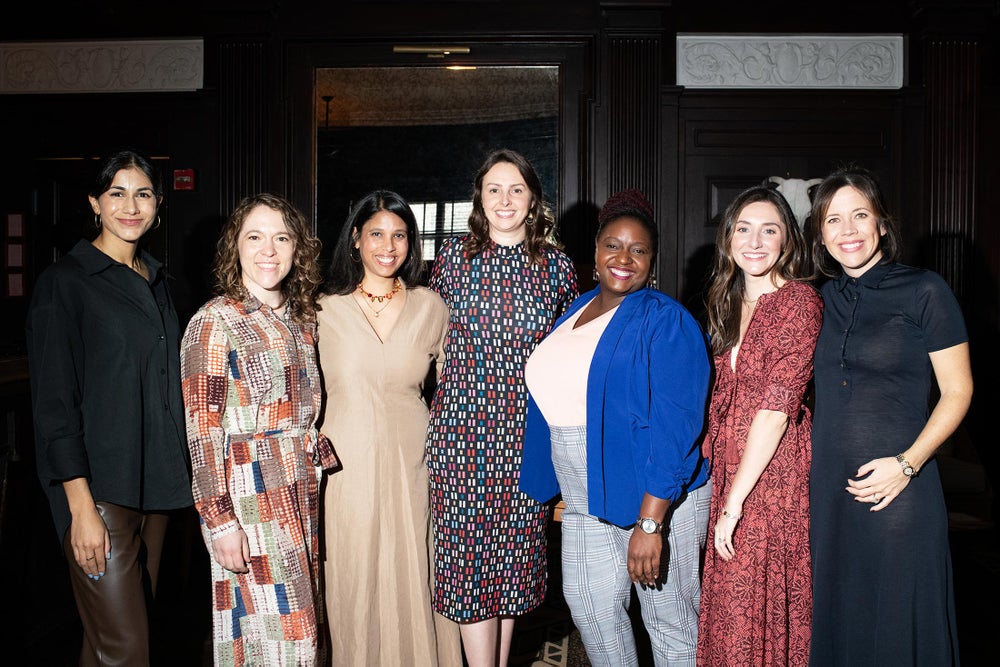How to Disrupt a Giant, Hopeless System Like Healthcare? Ask These Founders, Whose Startup Cuts Pregnancy Risks in Half.
Oula is a new pregnancy care startup that’s providing “incredible” results, while aligning the interests of insurance companies, hospitals, and patients.
There’s no way around it: The data on maternal mortality rates in the United States is disturbing. A 2020 report found that out of 10 other developed, high-income countries (Australia, Canada, France, Germany, the Netherlands, New Zealand, Norway, Sweden, Switzerland, and the United Kingdom) the U.S. came in dead last. And not by a small margin. Our maternal mortality rates are more than double the second-most-deadly country, France.
And it’s only getting worse. Between 2019 and 2021, the CDC reported a 60% rise in maternal mortality rates (and maternal mortality rates among Black women are 2.6 times higher than white women).
These are the statistics that Elaine Purcell and Adrianne Nickerson found themselves confronting when they decided to have children. Having both spent their careers in healthcare, they were shocked by how little investment was going toward innovation in the maternity care space. So they started digging into the data on countries that were doing it better, and found something interesting.
More than other places, the U.S. has moved away from traditional, hands-on (less expensive) pregnancy care from midwives, and toward more clinical (expensive) care from obstetricians (OBs). The vast majority of pregnancies start out low-risk, and would stay that way if women got the care they needed along the way. But our healthcare system makes it difficult for women to get sustained attention.
Related: 6 Cheap But Meaningful Ways to Boost Your Company’s Local Awareness
Purcell and Nickerson decided to build a clinic that fused traditional midwifery with the medical expertise of OBs. This more affordable care model would have a 6-to-1 ratio of midwives to OBs. The midwives would be able to provide ongoing care throughout the pregnancy, while the OBs vetted their medical advice and cared for higher-risk patients. And so, Oula, a “modern maternity center,” was born. Right now, Oula has two locations in New York City and an eye on expansion.

We spoke with Purcell and Nickerson about how they managed to build a healthcare startup that provides exceptional results while aligning the interests of patients, insurers, and providers.
How did the idea for Oula come about?
Nickerson: Elaine and I spent our entire careers in healthcare, from policy to big health systems to consulting. So when we decided to have kids it was only natural for us to do our research and figure out what sort of care we wanted. And if you’d asked me five, six years ago, “Are you gonna have a birth with a midwife?” I would’ve said, “No, I’m going to an OB at the hospital.” But in all the conversations we had with our friends, which is often the first place women turn to when they start to research, we realized that the system was, at best, impersonal and broken, and at worst, really dangerous.
Related: 7 Best Practices Your Healthcare Business Is Likely Overlooking
So then we started talking to payers, health systems, providers, and really anyone we could. What we landed on, in terms of what is fundamentally broken about maternity care in this country, is that you basically have a choice between an OB and a hospital, or a midwife and a home birth. And most people actually want an experience that sits in the middle. They want something that thinks holistically about their needs and marries the best of both worlds. When we realized this was the thing that we couldn’t stop thinking about, we left our jobs to build it.
What does a model look like that meets in the middle?
Purcell: So we looked at a lot of data, and saw that there are other countries doing it well. Based on all the data, our hypothesis was that you can’t really separate the pregnancy experience from [birth] outcomes. So by focusing on the experience — by slowing down communication, and making sure there is a trusted relationship between the provider and the patient — that’s how we’re gonna impact outcomes.
What that means is a collaborative care model of midwives and OBs. 85% of patients start off low-risk, so 85% of patients actually should have midwives because midwives are experts in low-risk births. But the way we’ve staffed our healthcare system is majority OBs, minority midwives. So we decided that we need one OB per clinic — from a quality perspective and if a patient rises in risk or needs a C-section — and multiple midwives.
Oula is the space where you come to meet clinicians, and we’re the modern tech that sits on top of it. Your pregnancy doesn’t happen in these 14 discrete little visits over nine months. It happens at all the moments in between. So the power of tech is really about extending care between appointments.
On a personal level, how does the Oula care experience feel different?
Purcell: We ask different questions than the majority of providers. We want to know what that patient is looking for in their experience, who they are, and what their pronouns are. How do they think about birth? Do they have a partner? Are they doing this alone? Frankly, we have a lot of patients who come to us saying that they felt disenfranchised by the healthcare system and our first appointment made them feel seen as a whole person.
Related: What Can ChatGPT Do for Healthcare Practices?
The visits also are a combination of virtual, in-person and group sessions. Over and over in our research, we’ve seen how isolating pregnancy is, so something powerful happens when you bring individuals together who are going through it at the same time. The healthcare system really treats it like this clinical thing, but so often you just want to turn to someone and say, “What bathing suit should I wear?” Or, “My partner is driving me nuts because he or she doesn’t understand what I’m going through.”
Then when you get to the postpartum period, our experience also looks very different, because that’s where so many bad outcomes happen. There’s just a wide variety of emotions that can happen. So we check in with a patient two weeks postpartum, then at six weeks, and have ongoing drop-in office hours for patients to meet with each other or a doula, and talk about breastfeeding and all of the various challenges.
Were there any big setbacks or pivots as you were building the business?
Nickerson: We raised seed capital during Covid, and it was insane. I’d say we talked to 70 or 80 investors. But the silver lining of fundraising in a difficult market was that we couldn’t raise as much money as we wanted to do a full iteration of our business — which, in the beginning, we thought would include a birth center. Because we wanted to control the whole experience, we thought that had to include where women delivered. But since we didn’t raise enough capital, we had to say, okay, well what is the smaller version of this model?

That meant offering care throughout the pregnancy at our office, but still delivering in the hospital. And once we started seeing the data from our patients who are delivering at the hospital, we were like, “Oh my gosh.” Our C-section rate is 50% lower than the benchmark. Our preterm birth rates and low birth weight babies are both half the national average. We were delivering incredible outcomes, and we didn’t have to worry about essentially rebuilding a hospital in a birth center.
Related: How Entrepreneurs Can Capitalize on the Digital Healthcare Revolution
We also realized, once we were operating, that the birth center as a business model was actually really challenging. As a healthcare company we had three customers: Patients, insurers, and providers. Insurers and patients were on board because it’s cheaper than a hospital. But when you’re building something outside a hospital birth center, you’re inherently antagonistic to a hospital, because a patient has a choice of delivering at your center or delivering at the hospital. And with a birth center, you still need the hospital, because people transfer from birth centers to hospitals if they’re in labor for too long. So you’re creating this entity that’s competitive with the hospital that you also need to be your partner.
It sounds like this is a lesson for any startup that wants to make an impact in a big, entrenched system, like healthcare.
Purcell: Both of us have studied the healthcare space extensively, and it really comes down to fundamentally bad incentives and broken economics — because the end user of healthcare is not actually the customer or the person who is paying for it. So, the most realistic solutions often involve incremental innovation. You have to understand how all the different stakeholder’s perspectives come into play.
Nickerson: With these large entrenched interests, I think you can have more of an impact and scale faster if you figure out how to align the incentives, as opposed to a lot of people in healthcare who try to burn it all to the ground or build it from the ground up. They don’t tend to be as successful.
There’s no way around it: The data on maternal mortality rates in the United States is disturbing. A 2020 report found that out of 10 other developed, high-income countries (Australia, Canada, France, Germany, the Netherlands, New Zealand, Norway, Sweden, Switzerland, and the United Kingdom) the U.S. came in dead last. And not by a small margin. Our maternal mortality rates are more than double the second-most-deadly country, France.
And it’s only getting worse. Between 2019 and 2021, the CDC reported a 60% rise in maternal mortality rates (and maternal mortality rates among Black women are 2.6 times higher than white women).
These are the statistics that Elaine Purcell and Adrianne Nickerson found themselves confronting when they decided to have children. Having both spent their careers in healthcare, they were shocked by how little investment was going toward innovation in the maternity care space. So they started digging into the data on countries that were doing it better, and found something interesting.
The rest of this article is locked.
Join Entrepreneur+ today for access.
Already have an account? Sign In






